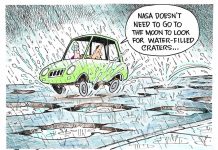Who’s up for a bracingly candid conversation about dope?
Let’s start with the immediate, local present and expand our considerations outward from there. One reason there are more decent-paying jobs in the Columbus area than there are people to fill them is that a significant percentage of applicants can’t pass the drug screen. Law enforcement officials will tell you that in nearly all crimes with which they deal — burglary, domestic violence, vandalism, etc. — the presence of some intoxicant is a common theme.
Libertarians and bohemians insist on making distinctions between substances. They point to peaceful tribal confabs such as Burning Man and Rainbow Gathering, or Ann Arbor, Michigan’s annual smoke-in and say, “You don’t see revved-up hotheads making trouble at these events.”
True enough, but let’s place them in a broader context. Beyond the confines of the neo-hippie segment of society, does anyone point to these events as agents of cultural enrichment?
Teaching jazz and rock history at IUPUC affords me some insights into the evolution of all this. Legendary record producer John Hammond used to tell Louis Armstrong that he didn’t need to smoke weed to be inspired to play trumpet like he did, and “Satch” vigorously disputed him. We can’t know for sure, given that he did indeed imbibe throughout his career. Still, Satch’s personal life was a trail of tumultuous marriages and tangled finances.
People speak of the Beatles achieving their full aesthetic flourishing after having been introduced to marijuana and LSD, and it’s true that there was an exquisite richness to their work in the 1965 to 1968 period, but by late 1969, John Lennon was reduced to his screechingly ugly cry for help, “Cold Turkey.” It seems there’s a shelf life to the initial burst of new inspiration to be derived from external agents.
I do what I can to dissuade my students from overly romanticizing the Bay Area scene of the late 1960s. “Summer of Love” and all that.
The truth is that it started out as a small group of beatniks, artists and college students — much like the bohemian enclaves that exist to this day — that, while not exhibiting much in the way of ambition or a desire to engage the world on its own terms, was essentially harmless.
With the first flurry of national media attention, however, runaways — primarily girls — from around the country boarded Greyhound buses for the West Coast and were met at the depot by hard drug dealers whispering, “Hey, darlin’, you need a place to crash tonight?”
Again, by that banner year of 1969, the Manson cult and the Altamont debacle had given the lie to the meme of unblemished communal comity. Flash forward to 1996 and consider the way Jerry Garcia died: slumped on the floor beside his bed at a rehab clinic, with a needle in his arm.
The debate about whether weed is a gateway drug or not has existed for a good 50 years.
Again, the Libertarians and bohemians point to the not-small number of smokers who don’t go on to anything harder.
The counter-argument, which can’t be denied, is that nearly any tale of addiction to the hard stuff involves a relationship with marijuana.
And so it is on the macro level. Marijuana was the first recreational drug to get mainstreamed. Psychedelics followed close behind, and then cocaine. Now, as we know, heroin is cheap and readily available right here in Columbus.
And is it coincidence that family dysfunction and resultant broken lives burgeoned over the same period as drug mainstreaming? A stretch, don’t you think?
Barney Quick is one of The Republic’s community columnists. All opinions expressed are those of the writer. He may be reached at [email protected].



